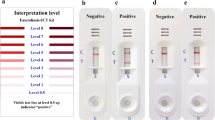Abstract
Microscopic identification of Entameba histolytica in stool is insensitive to differentiate this pathogenic ameba from morphologically identical Entameba dispar. An enzyme-linked immunosorbent assay method was applied for diagnosing amebiasis by detection of E. histolytica antibody. A total of 258 sample sera were analyzed from five different groups including amebiasis patients, E. histolytica/E. dispar asymptomatic cyst carriers, patients clinically presumed to have intestinal and extra-intestinal amebiasis and healthy control. From 51 E. histolytica/E. dispar cysts passers identified by microscopy and culture, a positive anti-amebic antibody was measured only for eight specimens (15.6%) and 43 cyst carriers showed an absorbance less than cut-off likely due to E. dispar infection. These findings suggest usefulness of ELISA method in differentiation of Entameba species, in clinical laboratories less equipped with biological and biochemical methods or antigen capture kits.

Similar content being viewed by others
References
Blessmann J, Buss H, Nu PA, Dinh BT, Ngo QT, Van AL, Alla MD, Jackson TF, Ravdin JI, Tannich E (2002) Real-time PCR for detection and differentiation of Entamoeba histolytica and Entamoeba dispar in fecal samples. J Clin Microbiol 40:4413–4417
Braga LL, Mendonca Y, Paiva CA, Sales A, Cavalcante ALM, Mann BJ (1998) Seropositivity for and intestinal colonization with Entamoeba histolytica and Entamoeba dispar in individuals in northeastern Brazil. J Clin Microbiol 36:3044–3045
Clark CG (2000) The evaluation of Entamoeba, a cautionary tale. Res Microbiol 151:599–603
Diamond LS, Clark CG (1993) Entamoeba histolytica, Shaudinn 1903, (Emended Walker, 1911) separating it from Entamoeba dispar, Brumpt 1925. J Eukaryot Microbiol 40:340–344
Diamond LS, Harlow DR, Cunnick CC (1978) A new medium for the axenic cultivation of Entamoeba histolytica and other Entamoeba. Trans R Soc Trop Med Hyg 72:431–432
Goncalves ML, da Silva VL, de Andrade CM, Reinhard K, da Rocha GC, Le Bailly M, Bouchet F, Ferreira LF, Araujo A (2004) Amoebiasis distribution in the past: first steps using an immunoassay technique. Trans R Soc Trop Med Hyg 98:88–91
Gonin P, Trudel L (2003) Detection and Differentiation of Entamoeba histolytica and Entamoeba dispar isolates in clinical samples by PCR and Enzyme-Linked Immunosorbent Assay. J Clin Microbiol 41:237–241
Gonzalez et al (1995) Prevalence of antibodies against Entamoeba histolytica in Mexico measured by ELISA. Epidemiol Infect 115:535–543
Grundy MS (1982) Preliminary observations using a multi-layer ELISA for detection of Entamoeba histolytica trophozoite antigens in stool samples. Trans R Soc Trop Med Hyg 76:396–400
Haghighi A, Kobayashi S, Takeuchi T, Masuda G, Nozaki T (2002) Remarkable genetic polymorphism among entamoeba histolytica isolates from a limited geographic area. J Clin Microbiol 40:4081–4090
Haque R, Ali IKM, Akther S, Petri JRWA (1998) Comparison of PCR, Isoenzyme analysis, and antigen detection for diagnosis of Entamoeba histolytica infection. J Clin Microbiol 36:449–452
Lowry OH, Rosebrough NJ, Farr AL, Randall RJ (1951) Protein measurement with Folin-phenol reagent. J Biol Chem 193:265–275
Petri JRWA, Haque R, Lyerly D, Vines RR (2000) Estimating the impact of amoebiasis on health. Parasitol Today 16:320–321
Randall GR, Goldamith RS, Shek J, Mehalko S, Heyneman D (1984) Use of the Enzyme-Linkd Immunosorbent assay (ELISA) for detection of Entamoeba histolytica antigen in fecal samples. Trans R Soc Trop Med Hyg 78:593–595
Robinson GL (1968) The laboratory diagnosis of human parasitic amobae. Trans R Soc Trop Med Hyg 62:285–294
Rosenblatt JE, Sloan LM, Bestrom JE (1995) Evaluation of an enzyme-linked immunoassay for the detection in serum of antibodies to Entamoeba histolytica. Diag Microbiol Infect Dis 22:275–278
Sargeaunt PG (1988) Zymodems of Entamoeba histolytica. In: Ravdin JI (ed) Amebiais, human infection by Entamoeba histolytica. Wiley, New York, pp 370–387
Shamsuzzaman SM, Haque R, Hasin SK, Hashiguchi Y (2000) Evaluation of indirect fluorescent antibody test and enzyme-linked immunosorbent assay for diagnosis of hepatic amebiasis in Bangladesh. J Parasitol 86:611–615
Tanyuksel M, Petri WA Jr (2003) Laboratory diagnosis of amebiasis. Clin Microbiol Rev 16:713–729
World Health Organization (1997) Entamoeba taxonomy. Bull World Health Organ 75:291–292
Acknowledgments
We gratefully acknowledge Dr. Seiki Kobayashi, Department of Tropical Medicine and Parasitology, School of Medicine, Keio University, Tokyo, Japan for providing positive E. histolytica antibody sera. We thank Dr. Fazel Shokri and S. Farnia, Tehran University of Medical Sciences and Health Services for assisting in the ELISA method. We also thank Dr. Seyed Mahmoud Sadjjadi, Shiraz University of Medical Sciences and Health Services for his helpful comments on the manuscript. This survey was supported by School of Public Health and Institute of Public Health Research, Tehran University of Medical Sciences and Health Services, Tehran, Iran.
Author information
Authors and Affiliations
Corresponding author
Rights and permissions
About this article
Cite this article
Haghighi, A., Rezaeian, M. Detection of serum antibody to Entameba histolytica in various population samples of amebic infection using an enzyme-linked immunosorbent assay. Parasitol Res 97, 209–212 (2005). https://doi.org/10.1007/s00436-005-1418-3
Received:
Accepted:
Published:
Issue Date:
DOI: https://doi.org/10.1007/s00436-005-1418-3



